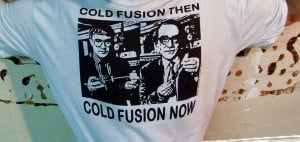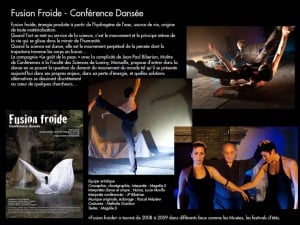Chicago Screening of The Believers from Eli Elliott on Vimeo.
The second premiere of the new Cold Fusion documentary, “The Believers” took place on Saturday, Oct. 20th as part of the Chicago International Film Festival. The night before, the film was awarded the Gold Hugo Award for Best Documentary Film of the Festival.

THE BELIEVERS focused mainly on the Martin Fleischmann – Stanley Pons story involving their announcement of Cold Fusion in 1989, and the aftermath to follow. Using this theme as a home base, the film weaved in some of the current crop of researchers, scientists, advocates and still skeptics.
We meet Edmund Storms, Robert Park, Martin Fleischmann, the assistant/grad student to Stanley Pons (Stanley declined to be interviewed), Irving Dardik, James Martinez, Eric Golab, and others.
Besides the event and aftermath of the ’89 Cold Fusion announcement, the film touches on patent issues, Hollywood’s fictional take on fusion, and ultimately the overall collision of media and science.
Having read and researched the subject of Cold Fusion for some years now, it was hard to judge or evaluate a portrait of such fitted into a 80 or so minute frame. Inevitably one will feel important aspects missing, or topics glossed over. But in the end, as a documentary which aims to tell a story, the filmmakers succeed in putting together a good film, likely turning on many people to Cold Fusion, the sordid history involved, and some of the main individuals, past and present.
The Approach.
Most seasoned Cold Fusion vets will likely have a problem with the chosen approach towards the subject matter. The filmmakers made the decision to go with the “mainstream viewpoint” established in the 90’s, now starting to seem archaic, of asking the “is it real or not” question. Many have already pointed out this viewpoint to be a purposeful slant that was perpetuated, propagated, from late ’89 into the 90’s, fueled by the usual suspects: politics, ego, greed, money, and more. I recall Melvin Miles in reference to the DOE report and their refusal to change his negative results to positive during that time even though he was now achieving positive results, saying how MIT was planning for negative results before they even wrote the paper and how politically they couldn’t have come out positive. Hence the myth of “junk science” was created. (And he later had work published showing the exact mistakes MIT made in their negative conclusions).
So it will be surprising to many, that now, after 20 years of positive published results from over 200 labs worldwide, published papers on the calorimetry mistakes at MIT, a positive light shown down from the mainstream 60 minutes news program, current companies developing prototypes with a strong push to go to market ASAP, that the real vs. non real angle would be chosen to paint the Cold Fusion picture, here in the year 2012.
As a YouTube comment pointed out for The Believers Trailer,
No belief necessary. Its now fact.
Nevertheless that was the chosen approach. Thankfully, with the very cool, calm and casual Edmund Storms frequently standing at the helm of the films pro Cold Fusion base, a convincing story is portrayed. Even a skeptic in the audience couldn’t help but describe Ed as the “fair minded man with the beard”.
The main naysayer was Robert Park, who likely came off to audience members as a legitimate voice in the discussion, though I’m not sure if the contradictions and unanswered accusations were picked up by said audience. Such as Park mentioning something to the effect that “if these guys want to question whether there is Cold Fusion then let ’em, I wouldn’t want to spend my life that way.” Yet he comes off as someone who has spent a good chunk of life engaged in trying to refute Cold Fusion, appearing in public as a naysayer, rather than residing in private to actually read the reports on CF results, something he’s apparently refused to do.
I should mention also, that the film carried a fairly heavy emotional sadness to it, mainly in respect to Martin Fleischmann; the abuse he had taken all those years in the field of his chosen livelihood, to the abuse he was now taking with Parkinsons. And of course the recent passing cements this sadness in further.
Besides Edmund, the film really shines with both James Martinez and the young high school aged Eric Gobal. These were two important figures in the film as James represented the current activism/advocate excitement of the Cold Fusion community, while Eric showed strong hope and added excitement as one who had already begun carrying the torch that Martin Fleischmann had handed off.
These two filled in some of the gap that the film left out from the absence of covering the very exciting current Cold Fusion scene, with various new companies and recent developments of LENR (just to add, a brief text update of Andrea Rossi was included at the very end). Much of which, as the filmmakers mentioned at the end of Q and A, could’ve meant at least an extra half hour tacked onto the film, and they questioned whether anyone would want to sit through more. But I believe viewers would gladly enjoy the exciting developments that Martin strongly helped inspire. And with civilization currently suffering so, any strong potential hope I feel could have been worth it; revealing just how far this has in fact currently come, and the closer than ever potential it now has to actually save the planet.
Nevertheless, as those will be some of the criticisms made, the main take away is a very engaging, very well made film (and now an “award winning” film meaning greater exposure), which included important figures as ground, and a much larger platform for further discussion. The reaction to the film overall seemed positive, though many questions I felt still hung in the air for many audience members.
I handed out ColdFusionNow stickers at the end of the screening, and unloaded several of the brand new ColdFusionNow T-shirts featuring Pons and Fleischmann at the after party screening.
Where will The Believers be showing in the future? Can you get a copy? They are awaiting word on more festivals, as well as seeing what distribution deals arise. By early next year they are looking for the film to be available for purchase. We’ll keep posted.







